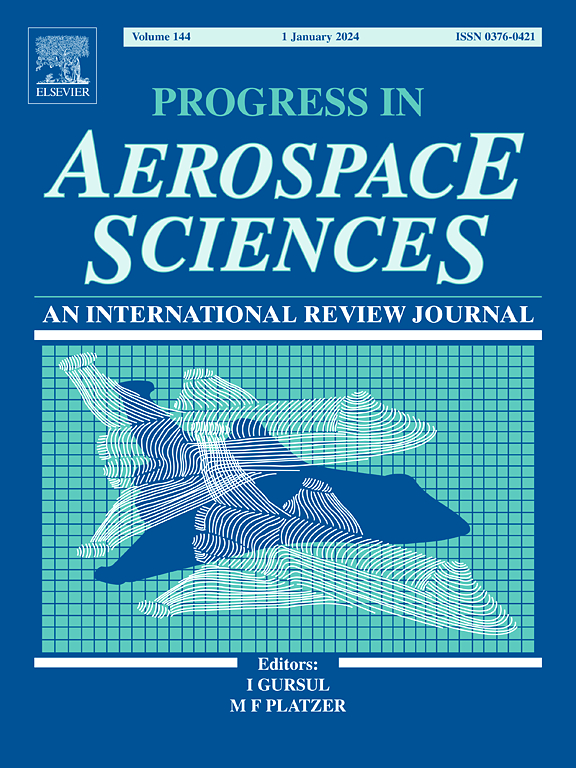氨与煤油尾迹:综述
IF 11.5
1区 工程技术
Q1 ENGINEERING, AEROSPACE
引用次数: 0
摘要
富氢燃料,如液态氨(LNH3),正被考虑用于新的商用飞机推进系统,以减少航空二氧化碳对气候的影响。确保整合这些燃料不会增加非二氧化碳对气候的影响是至关重要的,这违背了航空脱碳的目的。具体来说,人们担心通过更频繁和持续的凝结尾迹(凝结尾迹)会增加大气辐射强迫(RF)。最近的一些分析表明,氨尾迹可能在较低海拔(即较温暖的空气)形成,而且比煤油尾迹更频繁。在相同能量的基础上,与煤油发动机相比,每单位开尔文温度增加一公斤空气,nh3发动机可以消耗六倍多的水。nh3发动机排气羽流的热力学和微物理条件差异很大,这对现有的尾迹预测提出了质疑。目前的文献表明,减少烟尘颗粒作为传统煤油发动机羽流中的有效冰核(IN)可以通过降低冰晶数密度来消除尾迹。这样的建议没有考虑到不同的羽流特性和一系列影响尾迹形成的微物理现象,因此可能不容易推断为nh3尾迹。例子包括过饱和温度阈值的增加、环境颗粒效应、燃烧碳基燃料的飞机排放的预先存在的烟灰、均匀冻结机制的可行性,以及任何非烟灰系统耗尽的颗粒作为有效的in。因此,本综述旨在巩固煤油和氨尾迹的知识,并提供尾迹形成的热力学和微物理观点。本文章由计算机程序翻译,如有差异,请以英文原文为准。
Ammonia versus kerosene contrails: A review
Hydrogen-rich fuels, such as liquid ammonia (LNH3), are being considered for new commercial aircraft propulsion systems to reduce aviation’s CO2 climate impact. It is crucial to ensure that integrating these fuels does not increase non-CO2 climate impacts, defeating the purpose of decarbonizing aviation. Specifically, there are concerns about increased atmospheric radiative forcing (RF) via more frequent and persistent condensation trails (contrails). Some recent analyses show that ammonia contrails could form at lower altitudes (i.e., warmer air) and more frequently than kerosene contrails. On an equal energy basis, NH3-powered engines can exhaust six times more mass of water in every kilogram of air per unit Kelvin temperature increase compared to their kerosene-powered counterparts. The vastly different thermodynamic and microphysical conditions in the exhaust plume of NH3-powered engines query the existing understanding of contrail prediction. Current literature suggests that reducing soot particles as efficient ice nuclei (IN) in plumes of conventional kerosene-fueled engines could eliminate contrails by decreasing ice crystal number density. Such a proposal fails to consider the dissimilar plume properties and a range of microphysical phenomena that affect contrail formation—and thus may not be easily conjectured to NH3-contrails. Examples include an increase in the supersaturation temperature threshold, ambient particle effects, preexisting soot emitted from airplanes burning carbon-based fuels, the feasibility of a homogeneous freezing mechanism, and any non-soot system-exhausted particles serving as efficient IN. Hence, this review seeks to consolidate knowledge of kerosene and ammonia contrails and offer thermodynamic and microphysical perspectives on contrail formation.
求助全文
通过发布文献求助,成功后即可免费获取论文全文。
去求助
来源期刊

Progress in Aerospace Sciences
工程技术-工程:宇航
CiteScore
20.20
自引率
3.10%
发文量
41
审稿时长
5 months
期刊介绍:
"Progress in Aerospace Sciences" is a prestigious international review journal focusing on research in aerospace sciences and its applications in research organizations, industry, and universities. The journal aims to appeal to a wide range of readers and provide valuable information.
The primary content of the journal consists of specially commissioned review articles. These articles serve to collate the latest advancements in the expansive field of aerospace sciences. Unlike other journals, there are no restrictions on the length of papers. Authors are encouraged to furnish specialist readers with a clear and concise summary of recent work, while also providing enough detail for general aerospace readers to stay updated on developments in fields beyond their own expertise.
 求助内容:
求助内容: 应助结果提醒方式:
应助结果提醒方式:


